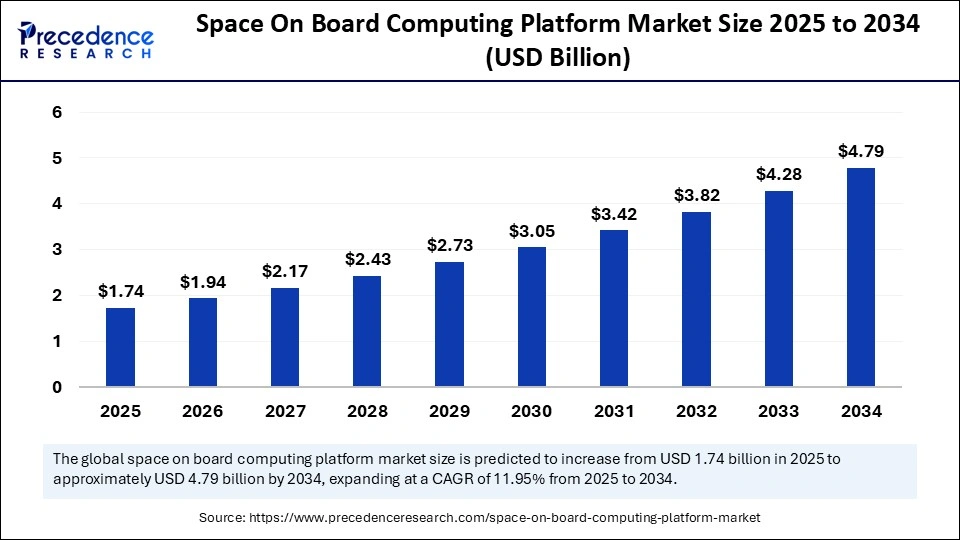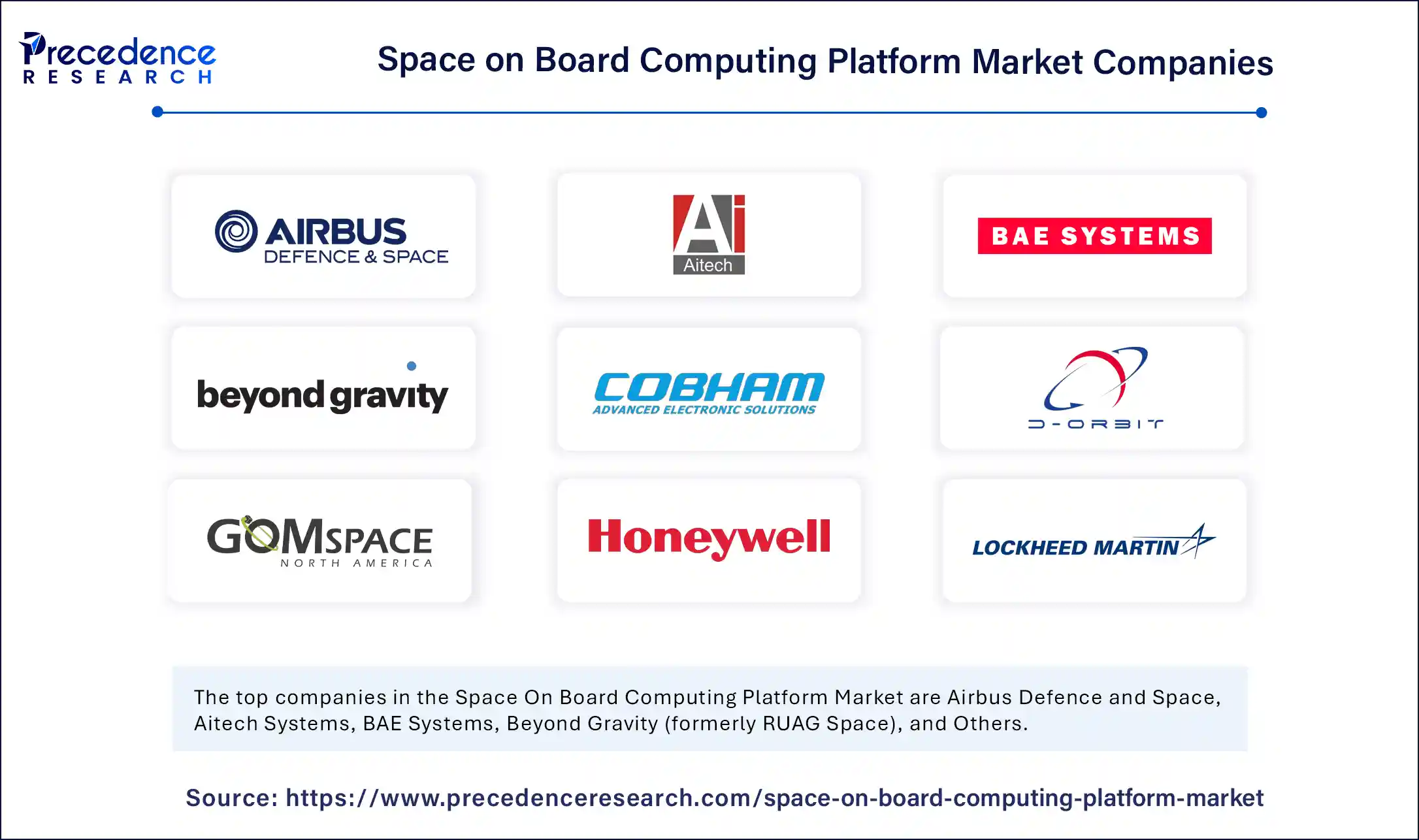Space On Board Computing Platform Market Size to Soar USD 4.79 Bn by 2034
Expanding at a CAGR of 11.95%, the market reflects an era of intelligent, autonomous spacecraft backed by advanced hardware and AI led by North America and propelled by Asia Pacific growth.
The space on-board computing platform market accounted for USD 1.55 billion in 2024 and is projected to climb to USD 4.79 billion by 2034 at a CAGR of 11.95% from 2025 to 2034.

This growth mirrors surging satellite launches, emerging space tourism, deep-space exploration, and defense ventures. Real-time data processing, mission autonomy, and energy efficiency now define winning strategies as private and government sectors push the boundaries of orbital innovation.
Space On Board Computing Platform Market Quick Insights
-
The market will reach USD 4.79 billion by 2034, climbing from USD 1.74 billion in 2025.
-
North America stands as the dominant region, while Asia Pacific is the fastest-growing.
-
The U.S. market will top USD 1.2 billion by 2034.
-
Hardware, particularly radiation-hardened processors and memory modules, remains the backbone.
-
Software, fueled by AI/ML, is becoming the fastest-growing component.
-
Medium and large satellites are the largest platform segment; small satellites (CubeSats, nanosats) are growing rapidly.
-
Earth observation and remote sensing lead applications, with space exploration surging ahead.
-
Government agencies such as NASA, ESA, and ISRO are primary end-users, but private companies like SpaceX and OneWeb are fast catching up.
-
Fault-tolerant architectures and AI-powered autonomy mark the technology frontier.
Space On Board Computing Platform Market Revenue Table
| Year | Global Market Value (USD Billion) | U.S. Market Value (USD Million) |
|---|---|---|
| 2024 | 1.55 | 379.75 |
| 2025 | 1.74 | 475.30 |
| 2034 | 4.79 | 1,198.82 |
AI-driven algorithms and machine learning models are reinventing the logic of space missions. Satellites now autonomously analyze mission data, optimize bandwidth, and detect anomalies, improving resilience and reducing operator intervention. AI-powered predictive fault detection and energy management allow satellites to independently adjust, refining navigation and minimizing response time.
Moreover, onboard AI accelerates real-time image recognition and geospatial mapping, empowering faster decision-making for defense and commercial missions. The market is steadily progressing from static processing units to intelligent platforms capable of adapting instantly to dynamic orbital scenarios.
What’s Powering Market Growth?
Robust investment in space exploration and satellite deployment, alongside a push for real-time onboard data analytics, drives the sector’s rapid growth. Key growth factors include:
-
Demand for advanced, autonomous computing in harsh space conditions.
-
Expansion of small and large satellite constellations for communications, defense, and remote sensing.
-
Commercial developments in space tourism and asteroid mining increasing mission diversity.
-
Rising interplanetary ambitions by both government and private entities.
-
Shift toward energy-efficient and modular designs to boost sustainability in orbit.
Space On Board Computing Platform Market Opportunities and Trends
What is the next growth engine for space on-board computing platforms?
AAI-enabled autonomous platforms and integrated IoT drive real-time decision-making and global connectivity, opening new frontiers as LEO constellations and Moon/Mars expeditions expand.
Which regions are poised for breakout growth—and why?
Asia Pacific’s aggressive space budgets and indigenous platform development, along with Europe’s eco-friendly R&D partnerships, create new competitive hubs to challenge North America’s dominance.
Where does sustainability meet innovation?
The evolving focus on energy-efficient, fault-tolerant computing solutions enables longer mission duration and reduced operational overhead, fueling green advances in satellite operations.
Space On Board Computing Platform Market Regional and Segmentation Analysis
-
Geography: North America leads global adoption, supported by NASA, SpaceX, and vigorous defense initiatives. Asia Pacific is the fastest-growing, with India, China, and Japan ramping up launches and indigenous platform capabilities.
-
Component: Hardware dominates, with radiation-hardened chips essential for survivability; however, AI/ML-powered software is quickly transforming mission intelligence.
-
Platform Type: Medium and large satellites handle complex payloads and are market leaders, with rapid growth in small satellites enabling democratized access.
-
Application: Earth observation and remote sensing are most prevalent, serving climate analysis and security, while interplanetary exploration marks the fastest-rising segment.
-
End-User: Government agencies anchor the sector, but commercial players and startups are accelerating market diversification.
-
Technology: Fault-tolerant architectures ensure mission reliability; AI/ML technologies power future autonomy.
-
Service Model: On-board data processing and on-board AI/machine decision-making are fast becoming operational norms.
Space On Board Computing Platform Market Companies

- Airbus Defence and Space
- Aitech Systems
- BAE Systems
- Beyond Gravity (formerly RUAG Space)
- Cobham Advanced Electronic Solutions (CAES)
- D-Orbit
- GomSpace
- Honeywell Aerospace
- Leonardo S.p.A.
- Lockheed Martin
- Northrop Grumman
- Raytheon Technologies
- Safran Electronics & Defense
Challenges: Navigating Costs and Risks
Several hurdles persist in this high-stakes market:
-
High costs of radiation-hardened components and prolonged design/testing cycles.
-
Limited power resources in orbit restrict system performance.
-
Increasing space debris and harsh operational conditions.
-
Volatile government funding cycles and cybersecurity threats.
Case Study: CubeSat Constellations Revolutionize Real-Time Monitoring
Universities and startups deploy AI-powered CubeSats for distributed Earth observation, dramatically reducing time-to-deployment and cost per mission. These constellations are now a proving ground for modular computing architectures and adaptive software, accelerating research and democratizing access to space technology.
Read Also: Enterprise Flash Storage Market
You can place an order or ask any questions. Please feel free to contact us at sales@precedenceresearch.com |+1 804 441 9344
